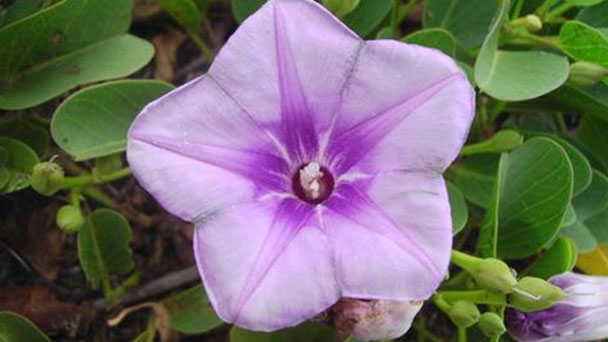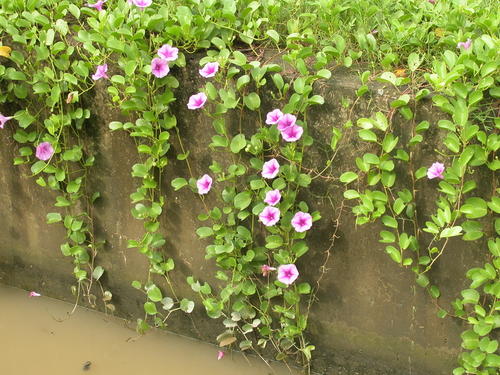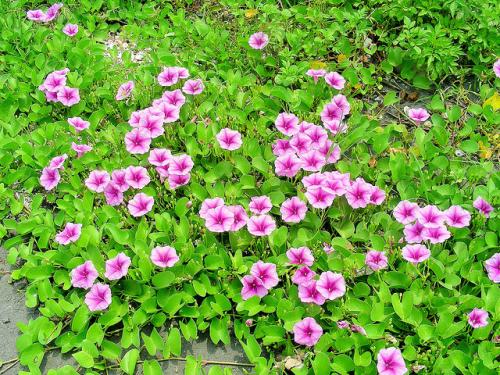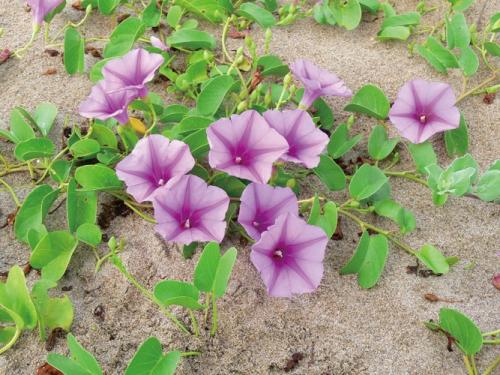Ipomoea pes-caprae profile
Written by Maggie
Mar 12 2021

Ipomoea pes-caprae, commonly called Bayhops, Beach morning glory, Goat foot, Goat's foot, Goats foot, Railroad vine is a perennial herb with alternate leaves and a thick leathery surface that prevents moisture loss and resembles a saddle. Ipomoea pes-caprae is a Pan-tropical plant that can be found almost all over the world in tropical coastal areas.
Ipomoea pes-caprae is found on hillsides, near the sea, or in trenches.Medicine and gardens are of higher value.
Ipomoea pes-caprae picture

Morphological characteristics of Ipomoea pes-caprae
Stems
Ipomoea pes-caprae is a perennial herb. The whole plant is smooth; Stems are very long and prostate.
Leaf
The leaves of Ipomoea pes-caprae are alternate, thickly leathery, with distinctly concave or nearly 2-lobed leaves, saddle-shaped, 4 -- 8 x 4 -- 10cm long, stalked, and up to 12cm long.
Flowers
Flowering of ipomoea pes-caprae is continuous throughout the year, with the peak in summer. Cymes, corolla purplish red, ca. 8cm in diameter. Calyx mostly 5, persistent, free, elliptic or broadly ovate; Corolla is actinomorphic, pink to purplish red, funnel-shaped, 5-lobed, 3.0 -- 6.5mm long; Stamens are alternate with lobes of corolla, 2 long and 3 short, base of filaments hairy: ovary superior, smooth glabrous, stigma 2-lobed.
Fruit
The capsules of Ipomoea pes-caprae are globose, 2-loculed, glabrous, 9 -- 16mm in diameter, greenish-yellow at first and brownish at maturity. Ipomoea pes-caprae has 4 seeds, black brown, its densely pilose.
Ecological habits of Ipomoea pes-caprae
Ipomoea pes-caprae grows on the beach and on the side of the road facing the sun. Ipomoea pes-caprae is found near the sea on hillsides, on the sand of rivers, by the sea or in ditches.
Ipomoea pes-caprae prefers high temperatures, dry conditions and sunny conditions. Ipomoea pes-caprae had good salt tolerance, wind resistance and drought resistance, but poor cold resistance and negative tolerance.
Cultivation techniques of Ipomoea pes-caprae
Ipomoea pes-caprae has adventitious roots growing out of the knobs of its stems, which can be replanted to form a new plant.
Ipomoea pes-caprae can be propagated by seed. Cultivation soil with sandy soil or sandy loam is the best. Drainage, sunshine needs to be good, fertilizer available organic fertilizer, 2 ~ 3 months a small amount of application. The suitable temperature for growth is 22 ~ 32℃.

The distribution region of Ipomoea pes-caprae
Ipomoea pes-caprae is distributed in Zhejiang, Fujian, Taiwan, Guangdong, Hainan and Guangxi provinces.
Ipomoea pes-caprae uses
Medical use
Ipomoea pes-caprae can dispel wind and dehumidify, pull out poison and determination, eliminate carbuncle, and sanjie. Ipomoea pes-caprae can treat cold, rheumatic joint pain, rheumatic arthralgia, lumbar muscle strain, urticaria, wind-fire toothache, fever, leucorrhea, eczema back carbuncle, etc. For external treatment of boils, hemorrhoids, wart cancer, swelling, ulcer, hemorrhoid leakage.
Landscape use of Ipomoea pes-caprae
Ipomoea pes-caprae is a typical sandy beach plant. It is also the first line plant to prevent wind and stabilize sand in sandy areas. It can change the micro-environment of sandy land to facilitate the growth of other plants, and has the functions of beautifying the coast and fixing sand.

Latest Updated
- Benefits of Bugleweed - 7 Science-backed Health Benefits
- Bugleweed Dangers & Side Effects - Is It Poisonous?
- How to Plant Evergreen Trees - What You Should Know
- When to Plant Evergreens - Grow Guide for Evergreen Trees
- 12 Wonderful Evergreen Shrubs for Your Garden
- 12 Popular Evergreen Plants with Pictures for Beginners
- When And How To Prune A Lilac Bush Like a Pro
- How to Grow & Care for Lilac Vine (Hardenbergia Violacea)
- Japanese Lilac Tree (Syringa Reticulata) Care & Propagation Guide
- Shumard Oak Pros and Cons - What to Know
Popular Articles
- Winter maintenance of Antirrhinum Majus
- How to Grow Terminalia Mantaly Tree
- How to Grow and Care for Crossostephium Chinense
- How to grow Antirrhinum Majus in spring
- Peristeria Elata (Dove Orchid) Profile: Info & Care Guide
- Underwatered Snake Plant (Sansevieria Trifasciata) - Signs And How To Fix
- How to Care for Brazilian Jasmine Plant (Mandevilla Sanderi)
- How to Grow & Care for Graptopetalum Purple Delight in Summer
- Rosa Chinensis (China Rose): Plant Growing & Care Tips
- How to Care for Baby Sun Rose (Aptenia Cordifolia)